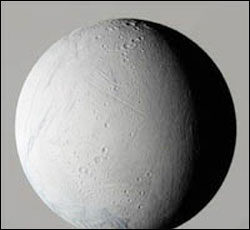University of Chicago instrument detects particles near Saturn’s moon Enceladus

Saturn’s moon Enceladus. Image credit: NASA/JPL/Space Science Institute.
Debris could be dust cloud around the moon
An instrument designed and built at the University of Chicago for the Cassini space probe has discovered dust particles around Enceladus, an ice-covered moon of Saturn that has the distinction of being the most reflective object in the solar system. The particles could indicate the existence of a dust cloud around Enceladus, or they may have originated from Saturn’s largest ring, the E-ring.
“We are operating on the plane of the E-ring, and things are very complicated there,” said Thanasis Economou, a Senior Scientist at the University of Chicago’s Enrico Fermi Institute. “It will take a few more flybys to distinguish the dust flux originating from the E-ring as opposed to one around Enceladus.”
The discovery is the first for the Chicago instrument, called the High Rate Detector. “During all this time from Earth to Saturn, we didn’t have any real test of the instrument. I was very happy to see that the instrument performs well after so many years,” Economou said.
The National Aeronautics and Space Administration launched Cassini, an international mission involving 17 nations, in October 1997. Last July, after a journey of 2.2 billion miles, Cassini became the first spacecraft to orbit Saturn.
Cassini scientists regard Enceladus as an increasingly interesting target. So much so that mission planners are revising the altitude of the next flyby to get a closer look. Additional Cassini encounters with Enceladus are scheduled for July 14, 2005, and March 12, 2008. The July 14 flyby was to be at an altitude of 620 miles, but the mission team now plans to lower that altitude to 109 miles. This will be Cassini’s lowest-altitude flyby of any object in the scheduled four-year tour.
Cassini encountered Enceladus at an altitude of 733 miles on Feb. 17. On that date, the Chicago instrument recorded thousands of particle hits during a period of 37 and a half minutes. Cassini executed another flyby of Enceladus on March 9 at an altitude of 311 miles. “Again we observed a high stream of dust particles,” Economou said.
The largest particles detected by the Chicago instrument measure no more than the diameter of a human hair-too small to pose any danger to Cassini. “Our measurements are important to evaluate any risk to the spacecraft,” Economou said.
The HRD is part of a larger instrument, the Cosmic Dust Analyzer, which with further analysis may be able to determine whether the particles are made of ice or dust. Enceladus measures 310 miles in diameter and reflects nearly 100 percent of the light that hits its ice-covered surface.
“If you look at the surface on Enceladus, it’s very smooth,” Economou said, and varies little in altitude. Scientists have speculated that Enceladus is the source of Saturn’s E-ring, the planet’s widest, stretching 188,000 miles. It is possible, the scientists say, that gravitational interactions between Enceladus and another moon of Saturn have triggered some form of water volcanism.
“The High Rate Detector measurements are extremely important in order to understand the role of Enceladus as the source of the water ice particles in the E-ring,” said Ralf Srama of Germany’s Max Planck Institute for Nuclear Physics, who heads the Cosmic Dust Analyzer science team. This study requires precise measurements of dust density in the Enceladus region, “but without the High Rate Detector this would not be possible,” Srama said.
Enceladus orbits Saturn at a distance of approximately 147,500 miles, almost two-thirds the distance from Earth to the moon. Only one of Saturn’s 31 known moons is closer to the planet.
The HRD was created by Anthony Tuzzolino, Senior Scientist in the Enrico Fermi Institute, under the direction of the late John Simpson, the Arthur Holly Compton Distinguished Service Professor Emeritus in Physics. The HRD was designed to collect data on Saturn’s rings and is capable of counting up to 100,000 impacts per second.
Cassini carries a total of 12 primary instruments that often must compete with one another so that the orbiter is properly oriented for collecting their data. “We did our best in order to make this happen, and the preparations and negotiations for these encounters were enormous,” Srama said. “These were perfect flybys, and we did everything possible.”
Media Contact
More Information:
http://www.uchicago.eduAll latest news from the category: Physics and Astronomy
This area deals with the fundamental laws and building blocks of nature and how they interact, the properties and the behavior of matter, and research into space and time and their structures.
innovations-report provides in-depth reports and articles on subjects such as astrophysics, laser technologies, nuclear, quantum, particle and solid-state physics, nanotechnologies, planetary research and findings (Mars, Venus) and developments related to the Hubble Telescope.
Newest articles

First-of-its-kind study uses remote sensing to monitor plastic debris in rivers and lakes
Remote sensing creates a cost-effective solution to monitoring plastic pollution. A first-of-its-kind study from researchers at the University of Minnesota Twin Cities shows how remote sensing can help monitor and…

Laser-based artificial neuron mimics nerve cell functions at lightning speed
With a processing speed a billion times faster than nature, chip-based laser neuron could help advance AI tasks such as pattern recognition and sequence prediction. Researchers have developed a laser-based…

Optimising the processing of plastic waste
Just one look in the yellow bin reveals a colourful jumble of different types of plastic. However, the purer and more uniform plastic waste is, the easier it is to…


